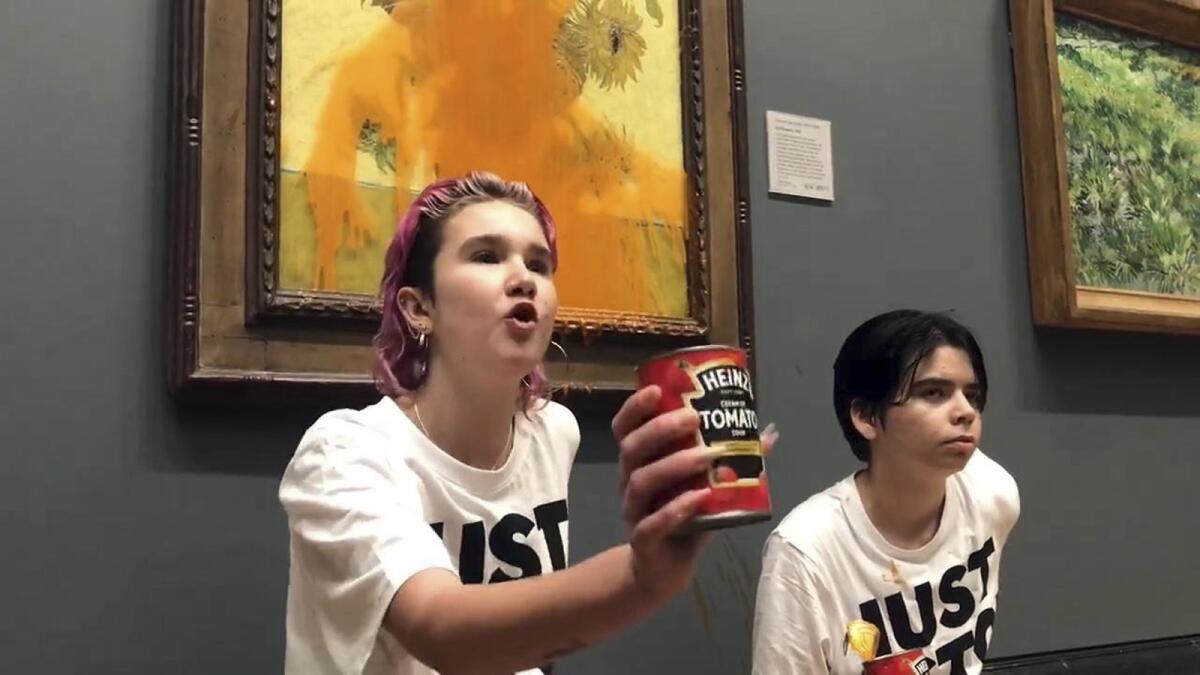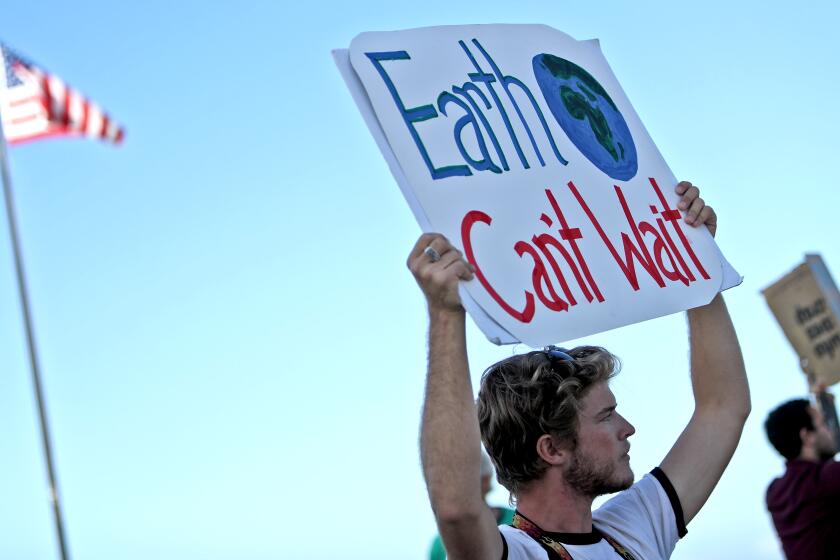Op-Ed: Is smearing food on the ‘Mona Lisa’ a productive form of climate change protest?

- Share via
In recent months climate activists have been in a food fight with art museums across Europe. Their protests include throwing tomato soup at a Van Gogh painting in London’s National Gallery and smearing cake on the protective glass over the “Mona Lisa.” Last week they threw mashed potatoes on the glass covering a Monet in a German museum. Aside from some minor damage to a few frames, none of the art has been harmed.
I used to work as a gallery attendant in a contemporary art museum before COVID hit. My job was twofold: protect the art and answer people’s questions. But mostly protect the art. None of the pieces where I worked was behind glass; many were worth more money than a Los Angeles mansion. My fellow gallery attendants and I were the only things standing between the art and all the people who came to take selfies with the works.
During one of my first shifts, a coworker told me not to spiral if anything happened under my watch because all of the art was insured. Often, when I was tired and bored out of my mind at work, I would think about how these paintings had better insurance than I did.
There is still part of me that flinches whenever I’m visiting a museum and I see someone getting too close to a piece of art. I have made visual art in some form for my entire life, so I have reverence for the physical care of an artwork.
And yet there is another part of me, formed in those long hours guarding wealthy people’s paintings for minimum wage pay, that was darkly delighted when I saw the food hit those paintings.
Take it from a permafrost scientist who takes her kids on research expeditions: There’s a way to talk to children about global warming that encourages inquiry rather than despair.
It’s the part of me that understands that the only way to make these and other powerful institutions pay attention to you is to get too close — especially to something of great value with a high price tag. A part of me that understands that this isn’t about hurting art — if it were, these activists would pick pieces that aren’t behind glass.
Some of the activists, from a group called Last Generation, have said that these protests are about getting a conversation going about climate change and others, from the group Just Stop Oil, have asked the question “What is worth more, art or life?” Last Generation has two demands on its website, both of which are specific to reducing emissions in practical ways, such as lowering the speed limit on German highways from 130 km to 100 km per hour. I imagine that these groups are also protesting the institutions, the way they seem to operate as though they are separate from anything happening outside their walls, separate from the lives of average people.
I waver in thinking whether the act of throwing food at a painting is or isn’t insane, on practical and philosophical levels. But I feel strongly that the sentiment behind the act is spot on. I feel insane reading the news most days. I feel insane throwing my cans into the recycling bin, bringing my totes to the grocery store, wondering if any of it even makes a dent.
I watch as climate scientists continuously update our expiration date, I watch the topic trend on Twitter after an emissions policy passes or fails, and then watch as it is replaced by something a celebrity has done. I watch all of us, myself included, going about our days as though they aren’t numbered — and none of it feels more or less insane than throwing soup at a painting.
Climate anxiety is the chronic fear of environmental doom. We’ll need to turn our anxiety into action if we want to make progress.
Whether or not smearing mashed potatoes on a glass-enclosed painting is an appropriate response, it feels like energy matching energy. We are facing extinction. More than that, we are creating it: We are the artists of our own extinction, painting ourselves out of the picture. If we are going to allow that then what is the point of the art we’re protecting? Who are we protecting it for?
I do wonder about the short-term effects of these protests. Will museums now become even less accessible than many already are because they fear for their artwork? Maybe more institutions will start putting up glass or locking people out — though I doubt it, if it keeps money from being made. Maybe humans will continue to focus more on protecting art than on protecting the Earth.
These activists feel to me like Earth’s version of gallery attendants running around telling us all to step back, we are getting too close. We’re walking straight past them. And then we’re somehow shocked that the hands that could nurture such a masterpiece could also be the ones that destroy it.
Jackie DesForges is a writer and artist in Los Angeles. @jackie__writes
More to Read
A cure for the common opinion
Get thought-provoking perspectives with our weekly newsletter.
You may occasionally receive promotional content from the Los Angeles Times.












